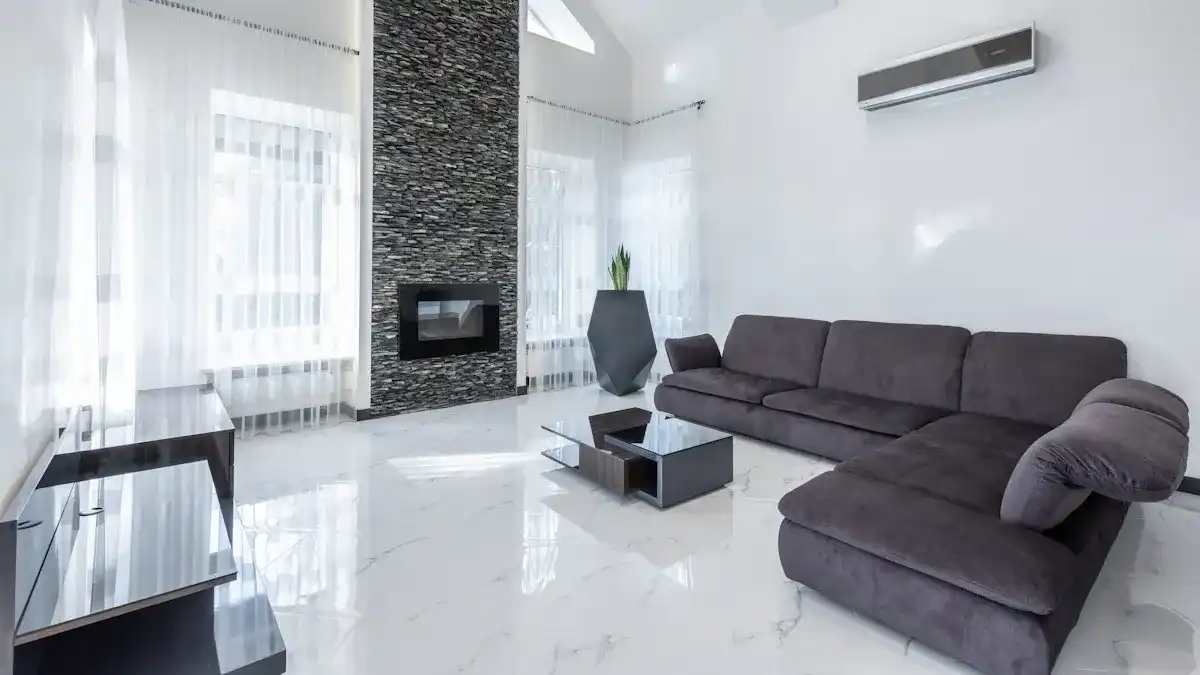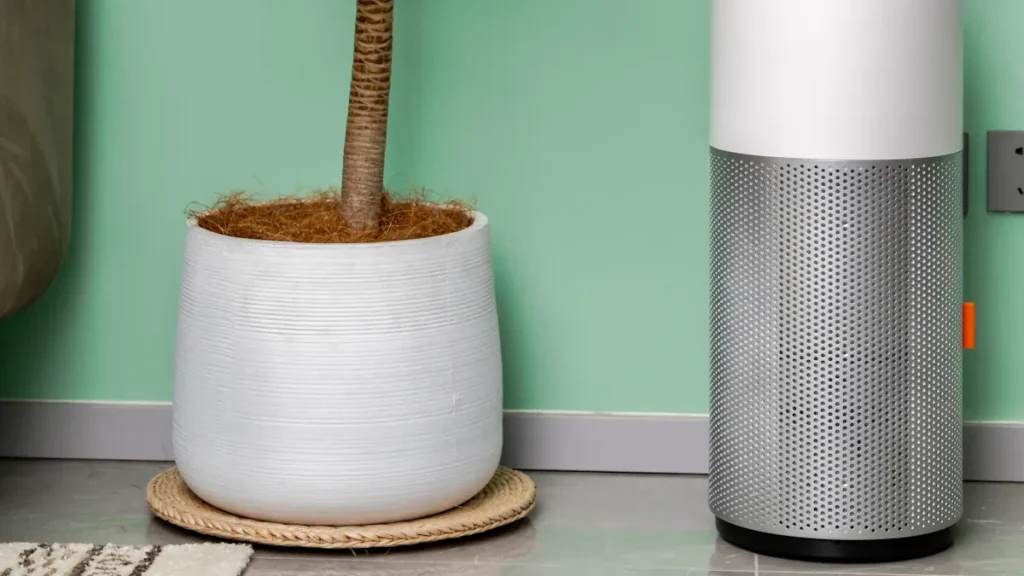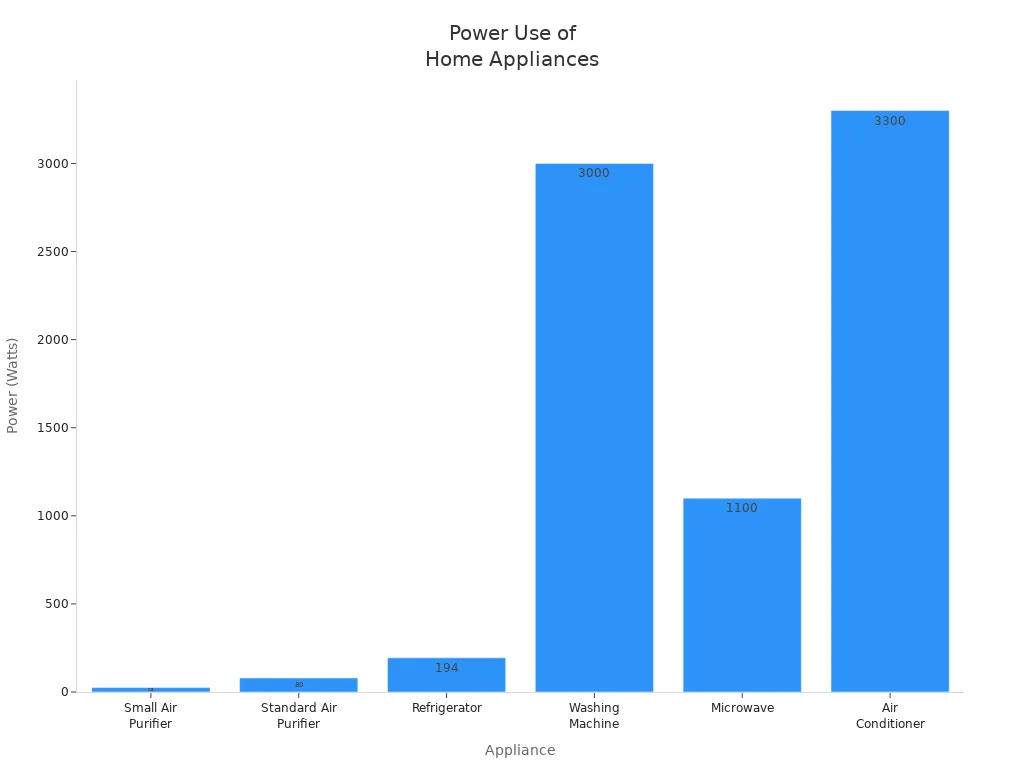
You can breathe better when your home has clean air. Many homes have tiny things like dust, smoke, or chemicals in the air. An air purifier helps by pulling in air. It traps bad particles. Then it sends clean air back into your rooms. Studies show air purifiers can lower indoor air pollution by 30% to over 60%. The amount depends on the filter and the room.
| Pollutant | Typical Indoor Concentration (μg/m³) | WHO Guideline (μg/m³) |
|---|---|---|
| PM2.5 | 1.7 – 428.6 | — |
| PM10 | 11.0 – 1275 | — |
| NO2 | 3.4 – 1210 | 200 (1h avg) / 40 |
| Benzene | 0.6 – 24.8 | 1.7 |
| Toluene | 3.0 – 325.5 | — |
| Formaldehyde | 7.5 – 134.0 | 100 |
| Naphthalene | 0.12 – 26.3 | 10 |
Key Takeaways
- Air purifiers take in air. They catch bad particles. They send clean air back into your rooms. This helps lower indoor pollution.
- Put your air purifier in an open, middle spot. Keep it away from walls or furniture. This helps air move better and clean more.
- Use air purifiers with more than one filter. HEPA filters catch small particles. Activated carbon filters remove smells. UV light kills germs. These work together to clean air well.
- Change the filters often. Run your air purifier all day. This keeps it working right and keeps air clean.
- Clean air from purifiers can help with allergies. It makes breathing easier. It helps you sleep better. It is good for your health.
How Air Purifiers Work

Air Intake and Circulation
When you turn on an air purifier, it starts by pulling in air. The fan inside brings air from your room into the device. This pulls in things like dust, pollen, and smoke. The air intake works best if the purifier is in an open spot. If you put it behind furniture or near a wall, it cannot work well. The purifier needs space to take in air.
Air circulation is also important. The fan pushes clean air back into your room. This helps spread clean air everywhere. Good air mixing removes more particles from the air. If you put the purifier near where pollution starts, it cleans faster. Putting it higher up can also help. In one study, daycare centers had 53-60% fewer particles in the air. Kids there also got sick less often when purifiers with strong airflow were used.
Tip: Put your air purifier in the middle of the room. Keep it running for the best results. Do not put it in corners or behind furniture.
You should check how much air your purifier can move. A higher airflow means it can clean your room more times each hour. For big rooms, pick a purifier with a high airflow rating. Dirty filters slow down the airflow, so change them often.
Filtration Process
After air goes into the purifier, it moves through different filters. Each filter catches certain pollutants. Here is a table that shows what each filter does:
| Filtration Stage | Pollutants Removed / Targeted Contaminants |
|---|---|
| Pre-Filter | Larger particles like dust, pet hair, lint, some pollen |
| HEPA Filter | Tiny allergens such as pollen, pet dander, mold spores, bacteria |
| Activated Carbon / Charcoal Filter | Odors, gases, VOCs, household smells |
| UV-C or Germicidal Light | Bacteria, viruses, mold spores (kills or deactivates pathogens) |
| Ionization / Electrostatic Precipitation | Charged particles like dust, allergens, some viruses |
| Photocatalytic Oxidation (PCO) | VOCs and chemical contaminants |
The filtration process uses different ways to trap or destroy pollutants:
- Straining and interception catch bigger particles.
- Diffusion helps catch very tiny particles.
- Electrostatic attraction makes particles stick to plates.
All the stages work together to remove as many pollutants as possible. For the best results, run your purifier often and keep the filters clean.
Note: Keep your air purifier running and put it in a good spot. Running it all day keeps your air clean, just like a heater keeps your room warm.
Air Purifier Filters

It is important to know how each filter works. Each filter type removes different things from the air. Most new air purifiers use more than one filter. This helps clean your air better.
| Filter Type | What It Removes | How It Works |
|---|---|---|
| HEPA | Dust, pollen, pet dander, mold, bacteria, viruses | Traps tiny particles in a dense fiber network |
| Activated Carbon | Odors, gases, VOCs | Adsorbs gases and smells onto porous carbon |
| UV-C Light | Bacteria, viruses, fungi | Uses ultraviolet light to destroy or inactivate microbes |
HEPA Filters
Most good air purifiers have HEPA filters. These filters catch almost all tiny particles. They trap things like dust, pollen, and pet dander. They also catch mold spores and some germs. Hospitals and labs use HEPA filters because they work well. Studies show HEPA filters lower indoor particles in real homes. You can trust them to help with allergies and keep your air cleaner.
Tip: Change your HEPA filter when needed. If it gets full, it cannot catch new particles.
Activated Carbon
Activated carbon filters help with smells and gases. You might smell food, pets, or smoke at home. These filters use special carbon with many small holes. The holes grab and hold gases and chemicals. They can catch VOCs like formaldehyde and benzene. Studies show activated carbon works well for removing odors and VOCs. If you want to get rid of smells, make sure your purifier has this filter.
UV and Other Technologies
Some air purifiers use UV-C light to kill germs. The UV-C light hurts the DNA or RNA of germs. This stops them from growing or spreading. Good UV systems can remove most germs in the air. Some purifiers also have ionizers or photocatalytic filters. These give extra protection. Always check if the device uses safe levels of UV or ozone.
Most air purifiers use more than one filter. When you use HEPA, activated carbon, and UV together, you get the best results for both particles and gases.
Indoor Pollutants
There are many things in indoor air that can hurt your health. You cannot always see these things. They come from what you do every day, from building materials, and from outside. If you know what is in your air, you can use your air purifier better.
Dust and Allergens
Dust and allergens are found in all homes. They hide in carpets, beds, and on things you touch. Dust mites, pet dander, mold spores, and pollen can cause allergies and asthma. More than 80% of kids with asthma react to at least one indoor allergen. If you have allergies, you might sneeze, have itchy eyes, or find it hard to breathe.
- Dust mite allergens can start asthma or make it worse.
- Mold and pet dander can cause allergic reactions.
- Kids who meet these allergens early may get asthma more often.
Tip: Put your air purifier in bedrooms and living rooms. This helps lower allergens and stops allergy flare-ups.
Smoke and Odors
Smoke and odors come from many things in your house. Cooking, candles, and tobacco smoke add particles and smells to the air. Tobacco smoke is very bad for you. It can cause asthma, heart problems, and cancer. HEPA filters in air purifiers can catch smoke particles, but not all harmful gases. Activated carbon filters help with some smells, but they do not fix everything.
| Pollutant | Sources | Health Concerns |
|---|---|---|
| Tobacco Smoke | Cigarettes, cigars, hookah | Asthma, heart disease, cancer |
| Smoke (general) | Cooking, wood burning, candles | Breathing problems, allergies |
| Household Odors | Cooking, pets, cleaning products | Discomfort, headaches |
The best way to keep air clean is to smoke outside. Air purifiers help, but they cannot remove all smoke dangers.
Microbes and VOCs
Microbes are things like bacteria, viruses, and mold spores. They can make you sick or cause allergies. VOCs are gases from paints, cleaners, and furniture. You may not smell them, but they can bother your eyes, nose, and throat. Some VOCs, like formaldehyde and benzene, can raise your cancer risk.
| Indoor Pollutant | Common Sources |
|---|---|
| Mold | Wet places, leaks, high humidity |
| VOCs | Paints, cleaners, furniture, glue |
| Formaldehyde | Carpets, pressed wood, glues |
Keep your home dry and let fresh air in. Use air purifiers with HEPA and activated carbon filters to help lower microbes and some VOCs.
Effectiveness
Room Size and Placement
To get the best results from your air purifier, you need to match its power to your room size. The Clean Air Delivery Rate (CADR) shows how much clean air the device can deliver each minute. Use the 2/3 rule: multiply your room’s square feet by two-thirds to find the minimum CADR you need. For example, a 300 sq ft room needs a CADR of at least 200. This helps you pick a purifier that can handle your space.
| Room Size Category | Recommended CADR Range (CFM) | Notes |
|---|---|---|
| Small rooms (up to 100 sq ft) | 100 – 150 | Suitable for small spaces |
| Mid-sized rooms (~200 sq ft) | 200 – 300 | Moderate CADR for average rooms |
| Large or open spaces | 300+ | Higher CADR needed |
You should place your air purifier in a central, open spot. Avoid corners or putting it against walls. Even a small gap, like 6 inches from the wall, can boost airflow and cleaning power. Keep the unit at breathing height for better results. Run your purifier all day, especially during allergy season or when pollution is high. Modern models use little energy, so you can leave them on without worry.
Tip: Continuous operation and smart placement help keep your air clean all the time.
Filter Maintenance
Keeping your air purifier working well means taking care of the filters. Here’s how you can do it:
- Always follow the manufacturer’s instructions for filter changes.
- Most HEPA filters last 6 to 12 months, but check more often if you have pets or allergies.
- Watch for filter change lights or alerts on your device.
- Look at your filters regularly for dirt or damage.
- Set reminders to change filters based on your home’s needs.
- Clean the outside and vents of your purifier to keep airflow strong.
- Store extra filters in a dry, clean place.
Regular filter changes keep your air purifier running at its best and help you breathe easier.
Safety and Energy Use
Modern air purifiers are safe and energy-efficient. Most use between 40 and 100 watts, which is less than a refrigerator or microwave.

Manufacturers design air purifiers to avoid safety risks. Some devices can make ozone, which can irritate your lungs. Look for models with certifications like CARB or UL 2998 to make sure ozone levels stay safe. Many purifiers have quiet modes, child locks, and stable bases. You can run your purifier all day without a big jump in your electric bill.
- Ozone output stays below safe limits in certified models.
- Multiple fan speeds help you control noise.
- Safety features protect kids and pets.
Choose an air purifier with safety certifications and energy-saving features for peace of mind.
Health Benefits
Allergy Relief
Air purifiers can help with allergies at home. HEPA filters lower allergy problems and help you feel better. If you put a HEPA air purifier in your bedroom or living room, you breathe in less dust, pollen, and pet dander. This means you sneeze less and can breathe more easily.
- HEPA air cleaners help people with asthma and allergies feel better.
- Kids with pet allergies have fewer problems at night when you use a purifier.
- Using a purifier with a HEPA filter and a special pillow cover can help your nose feel less stuffy and help you sleep better.
A study is checking if a HEPA plus VOC filter helps people with indoor allergies. The study looks at whether people need less medicine and feel better after using the purifier at home. You may have fewer allergy problems and need less allergy medicine if your air stays clean.
To control allergies, run your air purifier every day and change the filters when needed.
Better Sleep
Clean air helps you sleep better. When you use an air purifier, it takes away dust, pollen, and other things from your bedroom. This makes it easier to breathe at night. People with asthma or allergies wake up less and sleep longer when the air is cleaner.
Research shows that having fewer particles in the air helps people sleep better, especially if they have breathing problems. Air purifiers make your room cleaner, so you cough less and wake up feeling more rested. Some studies show that using a purifier can also lower blood pressure and help your heart, so you feel better overall.
Try running your air purifier at night to keep your bedroom air clean and help you sleep well.
You can keep your home healthier by removing dust, allergens, and odors with the right tools. When you choose a purifier, match its capacity to your room size, select filters for your needs, and check for quiet operation. Place it where air flows freely. Clean or replace filters on schedule and run the unit daily for best results. 🏡 Fresh air supports better sleep and comfort for your family.
FAQ
How often should you run your air purifier?
You should run your air purifier all day for the best results. If you want to save energy, use it when you are home or when air quality is poor. Continuous use keeps your air cleaner.
Where is the best place to put your air purifier?
Place your air purifier in the center of the room or near where you spend the most time. Keep it away from walls and furniture. This helps the device pull in and push out air more effectively.
How do you know when to change the filter?
Most air purifiers have a filter change light or alert. You can also check the filter for dirt or dust. If you notice less airflow or more dust in your home, it may be time to replace the filter.
Can air purifiers remove viruses and bacteria?
HEPA filters trap many bacteria and some viruses. UV-C light and other technologies can help kill germs. For best results, choose a purifier with both HEPA and UV features.
Do air purifiers make a lot of noise?
Most air purifiers run quietly on low settings. Some models have a “sleep” or “quiet” mode. If you need less noise, look for a purifier with a low decibel rating.
Tip: Check the product label for noise levels before you buy.
See also
What Air Purifiers Can Do to Remove Mold from Your Home
Whether one air purifier can be suitable for multiple rooms
What to Consider Before Putting an Air Purifier in Every Room
